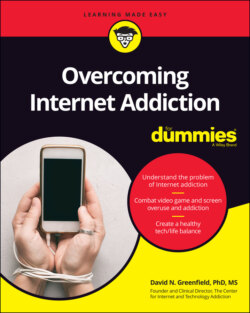Читать книгу Overcoming Internet Addiction For Dummies - David N. Greenfield - Страница 59
Seeing the Impact of the Internet and the “Maybe” Factor on the Developing Brain
ОглавлениеA susceptibility to addiction doesn’t necessarily result in addiction; there are many factors, including availability, ease of access, and emotions. Something must trigger it — an exposure to something desirable and pleasurable, along with other factors. The use of something pleasurable alone also doesn’t necessarily produce an addiction; most of us can engage in pleasurable activities and behaviors without becoming addicted. Rather, addiction is likely an interplay between opportunity, environment, genetic predisposition, biology, and various psychological factors — a perfect storm of sorts.
In addition, our brains learn to anticipate a pleasurable experience and to expect another fun time, and it seems this expectation may elevate dopamine even higher than the actual behavior itself. When you engage in a pleasurable activity, such as playing a video game, interacting on social media, watching a video, surfing on the web, or scrolling on your smartphone to satisfy your curiosity or manage your boredom, you’re elevating the release of the pleasure chemical dopamine in your brain. If you find something very pleasurable or interesting while you engage in those activities, then your dopamine level may become even more elevated. You may also be shutting down the connection to your brain’s frontal lobes and suppressing the release of GABA, the brain’s inhibition factor. (See the nearby sidebar “The evolutionary power of addictions.” Dopamine, the frontal lobes, and GABA are all covered earlier in this chapter.)
A pleasurable experience alone is probably not enough to trigger an addiction; if you experience a pleasurable behavior consistently, it is likely that eventually, you will become desensitized (bored) by it. Addiction is in part created by intermittent and variable pleasurable reinforcement, or what I like to call the maybe factor, and the brain’s pleasure center loves maybe like nobody’s business. When you or a loved one goes online through any device, it’s like sitting down in front of a slot machine and spinning those reels for the possibility of hitting it big. Every time you see something you enjoy, whether it’s a like on social media, a comment, a news feed, a photo, or a video, you are getting some small hit of dopamine. Notice that I said possibility, because if it were a certainty, your brain would get bored and come to expect the reward. When winning is a sure thing, the game soon loses its addictive impact.
The power of maybe to light up the pleasure centers of the brain is also observable in the pursuit of likes, comments, or follows on social media. Think of the drive people to get liked on Instagram, Facebook, or TikTok. Say you posted an amazing photo or video of you petting a baby kangaroo in Australia — the animal is taking the food right out of your hand! You love the photo, and you think others will, too. You’re excited while you wait to see how many likes you’ll get (or if you’ll get any). All this excitement produces a small neurochemical rush, and it’s all due to the power of maybe. If you knew for a fact that you would get a certain number of likes or comments in a certain time frame, you probably wouldn’t post — because it was expected, and less innervating.
The Internet, and especially social media, can be a search for our own echoes. A problem with waiting for likes and comments is that there is an unfortunate tendency to base your self-worth on the reflected echoes of how people respond to what you post. This pursuit of the like drives further posting and scrolling to a point where it can become addictive. Waiting for social media likes, comments, and follows can reinforce basing your self-esteem on what others think, and not on your own experience.
